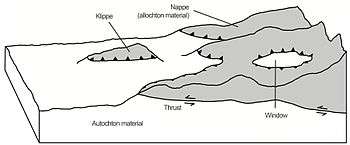Allochthon
In structural geology, an allochthon, or an allochthonous block, is a large block of rock which has been moved from its original site of formation, usually by low angle thrust faulting.[1] An allochthon which is isolated from the rock that pushed it into position is called a klippe. If an allochthon has a "hole" in it so that one can view the autochthon beneath the allochthon, the hole is called a "window" (or Fenster). Etymology: Greek; 'allo' = other, and 'chthon' = earth.
In limnology, allochthonous sources of carbon or nutrients come from outside the aquatic system (such as plant and soil material). Carbon sources from within the system, such as algae and the microbial breakdown of aquatic particulate organic carbon, are autochthonous. In aquatic food webs, the portion of biomass derived from allochthonous material is then named "allochthony".[2] In streams and small lakes, allochthonous sources of carbon are dominant while in large lakes and the ocean, autochthonous sources dominate.[3]
References
- DiPietro, Joseph A. (December 21, 2012). Landscape Evolution in the United States: An Introduction to the Geography, Geology, and Natural History. Newnes. p. 343. ISBN 9780123978066. Retrieved 10 February 2016.
- Grosbois, G., del Giorgio, P.A. & Rautio, M. (2017). Zooplankton allochthony is spatially heterogeneous in a boreal lake. Freshwat. Biol., 62, 474-490
- Eby, G.N., 2004, Principles of Environmental Geochemistry: Thomson Brooks/Cole, Pacific Grove, CA., 514 pp.
